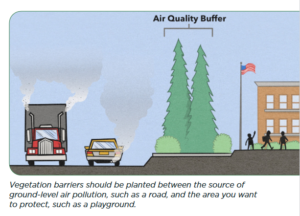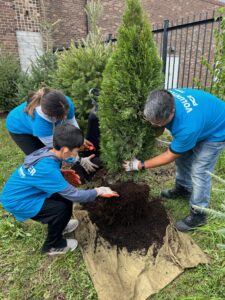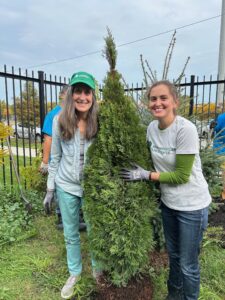November 02, 2023
Planting Vegetative Buffers to Protect Kids from Air Pollution
ELPC & partners plant trees at a school overlooking the Dan Ryan Interstate

Perspectives Charter School on Chicago’s South Side
Dozens of Chicago schools face excessive pollution from vehicle traffic. So, ELPC has been working with the Morton Arboretum, EPA Region 5, Illinois Department of Transportation, and local schools and volunteers on a project to protect students from highway pollution using natural barriers. Dense plantings of trees and bushes, known as vegetative buffers or vegetation barriers, can trap pollutants and improve air quality. This month, ELPC joined partners, students, and volunteers at Perspectives Charter School to help plant trees along the Dan Ryan Interstate in the Auburn Gresham neighborhood on the city’s South Side.
Protecting young lungs

Students dig holes for trees
While air pollution is bad for people of all ages, it is especially hard on children whose lungs are still developing. In some Chicago neighborhoods, up to 1 in 3 kids suffers from asthma, and at some of the city’s most vulnerable schools there are over 200,000 vehicles passing by every day. Combustion engines and road/tire wear create fine particulate matter pollution, which is small enough to bypass the body’s natural defenses and enter the lungs and bloodstream. Many schools have playgrounds, bus stops, or other outdoor areas directly adjacent to highways. Exposure is not limited to time spent outside — these schools often lack adequate filtration systems, allowing pollutants to circulate in the air that students breathe throughout the school day.

Image credit: Morton Arboretum Toolkit
Fortunately, studies show that vegetative buffers can often help. A vegetative buffer (also known as a vegetation barrier) is a dense planting of specific varieties of trees, bushes, and other plants which form a semi-porous barrier. These buffers physically block some pollutant-laden air; remarkably, they also filter out some hazardous particles as they pass through and accumulate on leaf surfaces.
Planting together

A family of volunteers from the Packaging Corporation of America & Boise Paper
In ELPC’s air quality monitoring program over the past few years, transportation corridors consistently emerged as major pollution sources. We used this data to identify the most vulnerable schools and began building partnerships to get this program off the ground (or in the ground, as the case may be!).
On Thursday October 26, a big group came out to do some planting. ELPC’s Lena Reynolds and Susan Mudd joined workers and volunteers from the Morton Arboretum’s Chicago Region Trees Initiative and the Packaging Corporation of America & Boise Paper’s UP Initiative at Perspectives Charter School on Chicago’s South Side. At times, the sounds of kids laughing and shovels digging were drowned out by the cars and trucks going by on the Dan Ryan Interstate (I-94) across the street, a poignant reminder of what we’re up against. Fortunately, the school is dedicated to protecting its students, and the Morton Arboretum staff are skilled facilitators, guiding the group with introductions, stretches, and how-to skills for tree planting.
What’s Next?

ELPC’s Susan Mudd and Lena Reynolds prepare a tree for planting
ELPC, US EPA, and the Morton Arboretum are in conversation with a number of schools to identify future planting opportunities. We’re also in talks with the Illinois Department of Transportation to line up future plantings with roadway repair projects whenever possible. Additionally, the Arboretum created a toolkit for schools and communities earlier this year. This is a great resource to help with planning, creating, and caring for vegetative buffers, while incorporating them into science curricula. Read more here:


